| Rally Finland | |
|---|---|
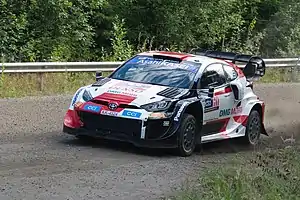 Esapekka Lappi at the 2022 Rally Finland | |
| Status | Active |
| Genre | Motorsporting event |
| Date(s) | July–August |
| Frequency | Annual |
| Location(s) | Finnish Lakeland |
| Country | Finland |
| Inaugurated | 1951 |
Rally Finland (formerly known as the Neste Rally Finland, Neste Oil Rally Finland, 1000 Lakes Rally and Rally of the Thousand Lakes; Finnish: Suomen ralli, Swedish: Finska rallyt) is a rally competition in the Finnish Lakeland in Central Finland. The rally is driven on wide and smooth gravel roads, featuring blind crests and big jumps. It is the fastest event in the World Rally Championship and has been dubbed the "Grand Prix of Rallying" and the "Grand Prix on Gravel". Rally Finland is among the largest annually organised public events in the Nordic countries, attracting hundreds of thousands of spectators each year. The rally has been known to be very difficult for non-Nordic drivers; only seven drivers from countries other than Finland or Sweden have won the event- in the 1980s and before, the field was made up almost entirely of Finnish and Swedish drivers.
The city of Jyväskylä in the Central Finland region has often served as the main venue for Finnish rally competitions,[1][2] because Rally Finland was first held under the name Jyväskylän Suurajot (Jyväskylä Grand Prix) in 1951. Originally an endurance event that stretched to Lapland in Northern Finland, the rally was at the forefront of the adoption of the modern rally format, splitting the route into a number of special stages in the mid-1950s. With increasing international attention, it became part of the European Rally Championship programme in 1959. After the start of the World Rally Championship in 1973, the event became the Finnish round in the series. Rally Finland is now among the most popular and prestigious rallies in the championship.
History
This rally began to gain importance in the 1970s, and local heroes such as Hannu Mikkola, Markku Alén, Timo Salonen, Tommi Mäkinen and Marcus Grönholm are the most successful names at this rally, and Swedish drivers such as Stig Blomqvist also found success at this rally. The difficulty of this rally for non-Nordic drivers made notable competitors such as Walter Röhrl (who never competed at this rally) and Miki Biasion (who only competed at this rally twice in his 15-year career) make rare or no appearances at this rally.
1950s

Rally Finland was started as a quickly improvised qualifier event for the Monte Carlo Rally; thirty Finnish drivers wanted to take part in Monte Carlo, but only 14 fit within the quotas on Finns and Swedes.[3] Previously, the entries had been decided in the Hanko Run in Southern Finland.[4] The regulations in this race were not close to those of the Monte Carlo Rally, leading to a demand for a Monte Carlo type of rally in Finland.[4] In July 1951, Pentti Barck's proposal for an annual competition in Jyväskylä was accepted.[4] The first-ever rally began on 1 September 1951 as Jyväskylän Suurajot (Jyväskylä Grand Prix). 26 entrants tackled the 1,700 kilometre (1,060 mi) route that stretched to Rovaniemi in Lapland, through Kokkola and Oulu, and back to the rally headquarters in Jyväskylä.[5] The winner Arvo Karlsson, driving an Austin Atlantic, had accumulated the least penalty points and had been the closest to the target times throughout the route and the special tests involving hillclimbing and acceleration.[6]
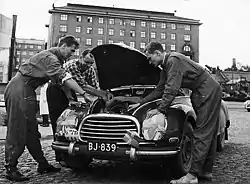
The 1952 event included Helsinki as an alternative starting point and the field expanded to 48 entries.[7] Eino Elo was the only driver to finish the route and the acceleration and braking tests without penalty points.[8] In 1953, Oulu was added as a third starting point, and 66 crews started the 2,200 kilometre course in two-minute intervals.[9] The 1954 running of the rally saw the introduction of the international name "The Rally of the Thousand Lakes".[10] There were now eleven starting cities, one of which was Sundsvall in neighbouring Sweden.[11] In 1955, the event became increasingly closer to the format of a modern rally competition; the number of special stages was increased to eleven, marking the highest amount in any European rally.[12] Elo and Peugeot became the first two-time winners of the event. The 1956 rally featured 19 stages totaling 1,800 kilometres (1,100 mi).[13]
In 1957, the rally had a record number of entries from foreign countries and the organisers developed a sign language that marshals could use to communicate with drivers.[14] The event also started the Finland-Sweden international in rallying,[14] comparable to the traditional Finland-Sweden athletics international. Sweden's Erik Carlsson drove his Saab 93 to victory as the first non-Finn. In the 1958 1000 Lakes, documented by a 20th Century Fox film crew,[15] seven drivers crashed out on the same curve on a foggy night.[16] Brothers Osmo and Eino Kalpala took a record third win in an Alfa Romeo Giulietta TI, which marked the first victory for an Italian car. In 1959, the 1000 Lakes Rally was included in the European Rally Championship calendar.[17] It was also one of the four rallies that counted towards the first-ever Finnish Rally Championship.
1960s

At the 1960 1000 Lakes Rally, nearly half of the 85 entries were from foreign countries.[17] A deaf-mute road worker was hit by Germany's future European champion Eugen Böhringer in what was the event's first fatal accident.[18] Although the rally ended with Finland's Carl-Otto Bremer leading home a Saab triple win,[19] the best Finn had been only tenth after the opening Harju hill stage.[20] Later in the 1960s, the 1000 Lakes was dominated by the first generation of "Flying Finns" of rallying. Rauno Aaltonen beat Pauli Toivonen to the win in 1961,[21] while Toivonen took the honours in 1962.[22] Esko Keinänen and Rainer Eklund finished second in a Škoda Felicia.[23] A record 104 drivers started the 1962 event.[24] Simo Lampinen, barely twenty years old, became the first driver to take consecutive wins, finishing ahead of Sweden's Tom Trana in 1963 and 1964.[25][26]
.jpg.webp)
Interest in the 1000 Lakes Rally continued to grow. It became known as the best organised rally competition after the Monte Carlo Rally,[27] and as Finland's biggest sporting event by audience count.[28] As practice had been allowed for 1965, speeds became higher than ever.[11] These factors brought several challenges to the organisers. Spectators lined up the edge of the course and sometimes even blocked the road.[29] One spectator was killed in a crash in 1965.[11] 1,200 officials were appointed for the 1965 event,[30] over 2,000 for 1967 and over 3,000 for 1968.[31][32] As the organisers and the gravel roads could not handle fields close to 200 cars, only 130 of the 173 entries qualified for the start in 1965.[17][27] In 1966, entries were only accepted from drivers who had finished in at least three rallies.[33]
Along with the number of entrants, the percentage of retirements grew steadily throughout the decade, and 1966 saw nearly half of the 115 drivers fail to finish the 26 stages.[17] Timo Mäkinen, who had already won in Monte Carlo, drove his Mini Cooper S to victory in 1965 and continued the success in 1966. In 1967, he beat Lampinen to the win by eight seconds despite driving the high-speed Ouninpohja stage with his bonnet open.[11] His hat-trick of wins was followed by Hannu Mikkola's successes in a Ford Escort TC. In 1968, Castrol produced a film titled Flying Finns, documenting the duel between Mäkinen and Mikkola. The 1969 rally saw the circuit and street stages, which favoured faster sports cars and factory team drivers, dropped from the programme.[34]
1970s

The 1970 1000 Lakes had a record 52 stages, which totaled 460 competitive kilometres.[35] An estimated audience of 350,000–500,000 spectators watched Mikkola match Mäkinen's feat of three wins in a row.[36] However, the event suffered a drop in the number of foreign entries, which the international press attributed to the difficulty of defeating the Finns on their own roads.[37] In 1971, the rally was won by a Swedish driver for the third time; Stig Blomqvist finished well ahead of Tapio Rainio and Markku Alén.[38] The 1972 event increased the length of special stages to almost 700 km.[39] The traditional Harju hill stage was left out of the route as Jyväskylä had banned racing in the city area.[40]

The 1000 Lakes was not among the five European rallies guaranteed a spot in the inaugural World Rally Championship calendar.[41] It competed for the remaining three Europe-based entries with the Coupe des Alpes (Alpine Rally), Österreichische Alpenfahrt (Austrian Alpine Rally), Rally Poland and Rallye de Portugal.[41] The number of rallies in the 1973 season was eventually expanded to 13 and only Coupe des Alpes was dropped. The 1973 1000 Lakes Rally ended with Ford's Timo Mäkinen becoming the first driver to win the event four times, and the first Finn to win a WRC round. Alén finished second in a Volvo and future Formula One driver Leo Kinnunen third in a Porsche.[42] The world championship status had brought back a strong international field of about 50 teams from 13 different countries.[43] The 1974 event was marred by the first fatal accident for a competitor in the World Rally Championship. Co-driver Seppo Jämsä died of injuries sustained in a crash in Ouninpohja.[44]
The rally route became a secret again in 1975, and pre-event practice was heavily limited.[45] Mikkola drove to a record fifth victory and Toyota became the first Japanese manufacturer to win the event. The 1977 and 1978 rallies were, in addition to the WRC, part of the FIA Cup for Rally Drivers, the predecessor to the drivers' world championship. In 1978, the course stretched to Kuopio and as a result 25 of the 45 special stages were new.[46] The 1979 1000 Lakes raised the highest number of accepted entries to 150, and all 134 competitors could start the rally.[47] World championship points were now awarded for drivers as well as for manufacturers. Fiat's Alén collected most by taking his third win in the event, ahead of Ari Vatanen and eventual champion Björn Waldegård.[48]
1980s
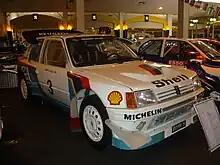
For the 1980 season, the 1000 Lakes Rally lost its status as a world championship event for manufacturers,[49] running for the first and last time only as a world drivers' championship event. The rally saw the return of the short Harju asphalt stage held in the center of Jyväskylä.[50] Although the rally became the first in the world to issue action and safety instructions in 1980,[51] several serious accidents marred the event in the early 1980s. At the 1981 rally, Austrian driver Franz Wittmann lost control of his Audi Quattro after the finish line of the fourth stage and crashed into five end-of-stage officials.[52] Raul Falin, the chairman of AKK-Motorsport, died of his injuries soon after reaching the hospital.[52] In 1983, Pekka Mällinen slid off the road on a fast curve, rolled twice and crashed into a thick pine tree.[44] The accident killed his co-driver Reijo Nygren.[44] At the 1984 rally, British driver Julian Roderick lost control of his car on a popular spectator area in the Humalamäki jumpers.[53] He rolled his car several times and hit a wall of people who had been spectating in a forbidden area.[53] Along with Roderick and his co-driver, nine spectators suffered non-critical injuries.[53]

Although the 1000 Lakes continued to be dominated by Nordic drivers, David Richards became the third British co-driver to celebrate the win in 1981. In 1982, the pre-rally scrutineering was moved to the newly built Jyväskylän jäähalli (Jyväskylä Ice Hall).[54] All over 150 contestants passed the inspection.[54] King Carl XVI Gustaf of Sweden arrived to follow the event and a record 450 reporters were present.[55] Dominant Audi took a one-two with its factory drivers Hannu Mikkola and Stig Blomqvist, with team orders keeping them in their positions for the last half of the race.[56][57] The 1983 rally featured a field of 180 cars, over a hundred of which failed to make it to the finish.[58] Mikkola edged out Blomqvist to extend the event record to a still-standing seven wins. Mikkola's time on the 24.5-kilometre (15.2 mi) Ouninpohja stage was 11:56; 52 seconds faster than his time just four years ago.[59] In 1984, over half a million spectators were expected and about 5,000 marshals were appointed.[60] Vatanen won the event and Peugeot continued their success in the last two Group B years, as Timo Salonen drove to victory in 1985 and 1986.
The 1985 event marked the first time the drivers' world championship had been decided in Finland; Salonen captured the title with three rallies to go.[61] In 1986, the route was modified to bring the average speeds closer to the FISA limit of 110 km/h.[62] The top drivers exceeded the limit almost regularly, but FISA had given the organisers a 10 percent flexibility.[62] Combined with their dislike for the slower Group A cars, drivers were highly critical of the organisers for artificially slowing the rally in 1987.[63] A record 214 drivers signed up for the 1988 event and 200 were qualified to start by the organisers.[64] Albert II, Prince of Monaco arrived to follow the event and was scheduled to drive a few stages in an ex-Alén Lancia.[65] In one of the tightest duels in the event's history, Toyota's Juha Kankkunen led Lancia's Markku Alén by just two seconds after 33 of the 39 stages.[66] Kankkunen's engine failed on the next stage,[66] and Alén became the first driver to win the same WRC round six times. As a taste of what was to come, only two Finnish drivers made it into top ten.[66] In 1989, Mikael Ericsson of Sweden drove to victory as the first non-Finn in 18 years.[67]
1990s
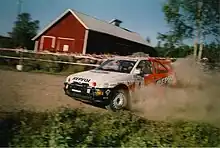
The 40th anniversary event in 1990 featured a route stretching to Tampere and gathered a large audience, roughly estimated at 450,000–500,000.[68] Toyota's Spanish driver Carlos Sainz became the first competitor outside Finland and Sweden to win the rally.[69] He had been slightly injured earlier during the week, when he crashed during a night-time practice run in the Vesala stage.[70] Sainz's feat was soon repeated; Didier Auriol, who had become the first Frenchman on the podium in his debut in 1988,[71] beat his Lancia teammate Kankkunen to the win in 1992.[72] Kankkunen took his second win in three years in 1993. In 1994, the rally was renamed to Neste 1000 Lakes Rally as Neste became the title sponsor.[73] A new super special stage was built at a slope of the Himos ski centre in Jämsä and it quickly proved popular among spectators.[74]
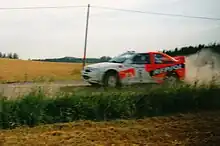
Due to the WRC round rotation from 1994 to 1996, the 1995 Rally Finland was only part of the 2-litre World Cup (better known as Formula 2). As a result, audience numbers dropped.[75] The event was also overshadowed by a fatal accident.[76] During the rainy and windy Hassi stage, a 20-year-old spectator did not hear the zero car driven by Bruno Thiry coming.[76] Although Thiry was able to dodge into a ditch, his car bounced back on the road and hit the woman at 100–120 kilometres per hour (62–75 mph).[76] She flew 50 metres (160 ft) down the road and succumbed to her injuries within minutes.[76] Next year in Harju, Danish driver Karsten Richardt carried far too much speed into a right-hander.[77] After hitting a bump and getting airborne, he missed the curve and went straight, hitting a road sign and a concrete barrier.[77] Uncontrollably airborne, his car eventually plunged into the crowd 70 metres (230 ft) off the course.[77] 29 spectators were brought to the hospital.[78] 45-year-old Belgian tourist Ludo Briers was operated on within 38 minutes, but his injuries soon proved fatal.[78] Before being hit, Briers had pushed one spectator to safety and protected another with his body.[79] In a subdued celebration, drivers from Central Finland manned the podium; Tommi Mäkinen took his third win in a row, ahead of Kankkunen and Jarmo Kytölehto.[80]
In 1997, AKK Sports, the marketing company of AKK-Motorsport, took over as the organiser and the WRC teams awarded the event for its safety efforts.[81] A new super special stage was built at Hippos, along with a VIP village for 1,600 people.[82] In the following year, teams voted the event as the Rally of the Year.[81] On his way to a record third consecutive title, Mäkinen set a record with his fifth Rally Finland win in a row.[83] Entry lists included ice hockey star and auto racing enthusiast Teemu Selänne, who finished 33rd in 1997 and 24th in 1998.[84][85] The event also attracted environmental criticism throughout the decade; protests gathered about a hundred participants in 1997 and two hundred in 1998.[86][87] In a 1997 study by the University of Jyväskylä, partly funded by AKK, Jyväskylä and Rally Finland, the environmental impact was estimated to be small; the noise from the rally cars, helicopters and speakers was considered the biggest harm.[88] In 1999, Harju was dropped from the route and extra points were awarded to the three fastest drivers of the Ruuhimäki stage, which was televised live by Yle to millions around the world.[89][90]
2000s


After years of rumours of the rally moving from Jyväskylä to Southern Finland for better accommodations, Tampere announced its intention to host the event after 1999.[91] Jyväskylä retained the event but the headquarters were relocated to the large newly built Paviljonki congress and trade fair centre.[92] Previously, Laajavuori had served as the competition centre for 30 years.[92] The Hippos super special was dropped in favour of a similar stage at the Killeri harness racing track by the lake Killerjärvi, where the audience had better visibility of the competing cars.[93] The 50th running of the Rally Finland in 2000 was won by Peugeot's Marcus Grönholm, who would go on to dominate the event. In 2002, Englishman Richard Burns challenged teammate Grönholm to become the third non-Nordic competitor to win the rally, but broke his car on a jump in Ouninpohja while leading the event.[94] The next foreign winner was Ford's Estonian driver Markko Märtin in the following year. For the first time in the history of the event, no Finnish driver made it onto the podium.[95]

Rally Finland was chosen the "Rally of the Year" for the third year in a row in 2004.[96] Despite Lahti entering the race,[97] a unanimous decision was made to keep Jyväskylä as the rally headquarters.[98] In 2005, Grönholm set the still-standing record for the highest average speed in a world rally; 122.86 kilometres per hour (76.34 mph).[99] In the 2007 Rally Finland, Grönholm equalled Mikkola's win record and became the first driver to win the same WRC event seven times.[100] At the 2008 rally, Sébastien Loeb added his name to the list of non-Nordic winners. This also marked Citroën's first win since 1962.
As the World Rally Championship reintroduced round rotation in 2009, Rally Finland signed a five-year contract with WRC promoter International Sportsworld Communicators (ISC), insuring that the event stays in the calendar annually.[101] The 2010 event saw a major change; the rally was run in two days instead of three and finished on Saturday.[102] Ford's Finns Mikko Hirvonen and Jari-Matti Latvala took their debut home wins in 2009 and 2010, respectively. At the 2011 Rally Finland, Loeb made history by becoming the first non-Finn to win the event twice.[103] The event expanded to Lahti in the south and brought classic rally cars to the route, as some of the stages were also part of the Lahti Historic Rally.[104]
Characteristics
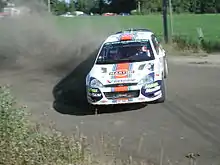
Geographic features
Rally Finland is known for its smooth and wide gravel roads, numerous big jumps (or yumps) and blind crests.[105]
It is the highest-speed rally in the World Rally Championship, having averaged 125.4 km/h in 2015. Of the nine fastest-ever WRC rallies by average speed, eight are editions of the Rally Finland.[105] As a result, it has become known as the "Grand Prix of rallying", "Finnish Grand Prix" and "Gravel Grand Prix".[106][107][108]
The high number of jumps led to the nickname "The Rally of the Thousand Jumps".[109] Formula One world champion Kimi Räikkönen said that the event "is probably the closest to asphalt driving as you can get on gravel."[110] According to The Sydney Morning Herald, the roads are considered the best in the world championship.[111] As the high-speed corners are often surrounded by trees, carefully crafted pacenotes and correct racing lines are necessary to survive the event; small errors easily lead to big crashes.[105]
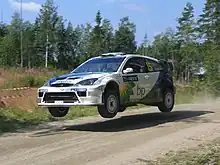
Popularity
Although Rally Finland has traditionally been a difficult event for non-Nordic competitors, it is popular among drivers as well as fans. The rally attracts hundreds of thousands of spectators each year,[112] and only Monte Carlo Rally and Wales Rally GB have ever attracted more starters.[113] Along with the Wales Rally GB, it is the only event to have featured in all but one WRC season.[114] The WRC teams voted Rally Finland the "Rally of the Year" in 1998, 2002, 2003 and 2004.[96] The official website of the World Rally Championship lists the event as one of the "undoubted highlights" of a season.[105]
Ouninpohja stage
The most famous competitive section of the rally is Ouninpohja. Well known for its high-speed jumps and sweeping corners, it ranks among the most prestigious special stages in the world. At one jump located 6 kilometres (3.7 mi) from the start line, close to a landmark yellow house, spectators measure the length of the jumps and mark the distance by the roadside. In 2003, Markko Märtin set the record for the longest jump, travelling 57 metres (187 ft) in the air at a speed of 171 kilometres per hour (106 mph).[115]
The Ouninpohja stage was split into two parts for the 2005 and 2006 events, as Petter Solberg had exceeded the FIA's maximum average speed (130 km/h) in 2004.[116] The rule was changed for 2007 and Ouninpohja returned as a 33 km (21 mi) version, although the organisers added three chicanes. However, the stage was left out of the route in 2008. Jarmo Mahonen, managing director of AKK Sports, stated that "the matter was discussed with the FIA already last year, and at the time we were able to keep Ouninpohja as a part of our route. This year we have to leave it out for safety reasons."[117] In 2012, the Ouninpohja stage returned and also served as the power stage.[118] The stage ranges from 97 m to a maximum of 180 m in elevation.
Winners

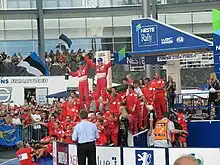


Multiple winners
|
|
Notes
- A Due to the World Rally Championship round rotation, the 1995 rally counted only for the 2-litre World Cup.
References
- ↑ Neste Rally Finland – Kosunen Racing
- ↑ Why is Jyväskylä The Capital of Sport? – Jyvaskyla.fi
- ↑ ""Matkailuajosta" Euroopanmestaruusralliksi" (PDF). Keskisuomalainen (in Finnish). 18 August 1967. p. 21. Archived from the original (PDF) on 6 June 2013. Retrieved 28 November 2011.
- 1 2 3 "Desire for World Class Rallying". Neste Oil Rally Finland. Archived from the original on 3 November 2011. Retrieved 1 December 2011.
- ↑ "Jyväskylän suurajojen ensimmäinen lähtö tapahtui eilen aamulla jo klo 5" (PDF). Keskisuomalainen (in Finnish). 2 September 1951. p. 2. Archived from the original (PDF) on 15 August 2010. Retrieved 27 November 2011.
- ↑ "A. Karlsson ja H. Korppoo selvisivät 1. miinuksella Jyväskylän Suurajoissa" (PDF). Keskisuomalainen (in Finnish). 3 September 1951. p. 1. Archived from the original (PDF) on 21 August 2010. Retrieved 27 November 2011.
- ↑ "Viime yönä alkaneeseen Jyväskylän suurajoon..." (PDF). Keskisuomalainen (in Finnish). 13 September 1952. p. 8. Archived from the original (PDF) on 17 August 2014. Retrieved 27 November 2011.
- ↑ "Toiset J:kylän suurajot voitti Elo Nuortila "puhtaalla pelillä"" (PDF). Keskisuomalainen (in Finnish). 15 September 1952. p. Back page. Archived from the original (PDF) on 17 August 2014. Retrieved 27 November 2011.
- ↑ "Jyväskylän Suurajot alkoivat eilen" (PDF). Keskisuomalainen (in Finnish). 12 September 1953. p. 9. Archived from the original (PDF) on 9 August 2014. Retrieved 27 November 2011.
- ↑ "Ajajat taivalta taittamassa" (PDF). Keskisuomalainen (in Finnish). 21 August 1954. p. 1. Archived from the original (PDF) on 18 April 2014. Retrieved 27 November 2011.
- 1 2 3 4 "Alkuaikojen leppoisa matkailuajo muuttunut tallien kovaksi kisaksi" (PDF). Keskisuomalainen (in Finnish). 20 August 1970. p. 22. Archived from the original (PDF) on 16 August 2010. Retrieved 28 November 2011.
- ↑ "Jyväskylän V Suurajot alkoivat eilen" (PDF). Keskisuomalainen (in Finnish). 20 August 1955. p. Back page. Archived from the original (PDF) on 18 April 2014. Retrieved 27 November 2011.
- ↑ "Jyväskylän Suurajot alkoivat" (PDF). Keskisuomalainen (in Finnish). 18 August 1956. p. 1. Archived from the original (PDF) on 9 August 2014. Retrieved 27 November 2011.
- 1 2 "Kansainväliset huippuajajat aloittavat tänään Harjulla kamppailunsa voitoista" (PDF). Keskisuomalainen (in Finnish). 16 August 1957. p. 9. Archived from the original (PDF) on 9 August 2014. Retrieved 27 November 2011.
- ↑ "Kalpala-Kalpala ylivoimainen voittaja Suurajoissa" (PDF). Keskisuomalainen (in Finnish). 25 August 1958. p. 2. Archived from the original (PDF) on 9 August 2014. Retrieved 27 November 2011.
- ↑ "Suurajo myös metsään" (PDF). Keskisuomalainen (in Finnish). 24 August 1958. p. 9. Archived from the original (PDF) on 9 August 2014. Retrieved 27 November 2011.
- 1 2 3 4 "Suurajot ensi kertaa EM-osakilpailurallina" (PDF). Keskisuomalainen (in Finnish). 18 August 1967. p. 22. Archived from the original (PDF) on 6 June 2013. Retrieved 27 November 2011.
- ↑ Mäntylä, Ari; Puranen, Tuula (27 August 1995). "Ihmiset eivät uskoneet puhetta" (PDF). Keskisuomalainen (in Finnish). p. 12. Archived from the original (PDF) on 30 May 2013. Retrieved 8 December 2011.
- ↑ "Pari Bremer – Lampi löi Carlsson – Simonssonin" (PDF). Keskisuomalainen (in Finnish). 22 August 1960. p. 2. Archived from the original (PDF) on 15 August 2010. Retrieved 27 November 2011.
- ↑ "J:kylän Suurajoilla yleisömenestys" (PDF). Keskisuomalainen (in Finnish). 20 August 1960. p. 9. Archived from the original (PDF) on 15 August 2010. Retrieved 27 November 2011.
- ↑ "Suomalaisille kolmoisvoitto XI Jyväskylän Suurajoissa" (PDF). Keskisuomalainen (in Finnish). 21 August 1961. p. 9. Archived from the original (PDF) on 6 June 2013. Retrieved 27 November 2011.
- ↑ "Citroën and rally Finland: four wins since 1962". Citroën Racing. 25 July 2014. Archived from the original on 31 July 2014. Retrieved 27 July 2014.
- ↑ Björklund, Bengt, ed. (September 1962). "Böhringer på väg mot EM?" [Böhringer on his way to a European Championship?]. Illustrerad Motor Sport (in Swedish). No. 9. Lerum, Sweden. pp. 6–7.
- ↑ "Jyväskylän XII Suurajot alkoivat" (PDF). Keskisuomalainen (in Finnish). 18 August 1962. p. 11. Archived from the original (PDF) on 6 June 2013. Retrieved 27 November 2011.
- ↑ ""Koululainen" voitti Suurajot" (PDF). Keskisuomalainen (in Finnish). 19 August 1963. p. 9. Archived from the original (PDF) on 6 June 2013. Retrieved 27 November 2011.
- ↑ "Simo Lampinen teki suurajohistoriaa viemällä toisen peräkkäisen voiton" (PDF). Keskisuomalainen (in Finnish). 17 August 1964. p. 8. Archived from the original (PDF) on 6 June 2013. Retrieved 27 November 2011.
- 1 2 "Vain 26 autoa lähti 14 vuotta sitten Suurajoihin – tänään starttaa reitille yli 100 autoa enemmän" (PDF). Keskisuomalainen (in Finnish). 20 August 1965. pp. 12–13. Archived from the original (PDF) on 6 June 2013. Retrieved 27 November 2011.
- ↑ "Yleisömäärät pikataipaleilla ovat tuhansissa" (PDF). Keskisuomalainen (in Finnish). 23 August 1965. p. 9. Archived from the original (PDF) on 6 June 2013. Retrieved 27 November 2011.
- ↑ "Yleisön käyttäytyminen pikataipaleilla on holtitonta" (PDF). Keskisuomalainen (in Finnish). 16 August 1964. p. 12. Archived from the original (PDF) on 6 June 2013. Retrieved 27 November 2011.
- ↑ "1200 toimitsijaa" (PDF). Keskisuomalainen (in Finnish). 21 August 1965. p. 11. Archived from the original (PDF) on 6 June 2013. Retrieved 27 November 2011.
- ↑ "Järjestelykoneisto on paisunut vuosi vuodelta" (PDF). Keskisuomalainen (in Finnish). 18 August 1967. p. 17. Archived from the original (PDF) on 6 June 2013. Retrieved 28 November 2011.
- ↑ "Suurajot vaativat suurmiehistönkin" (PDF). Keskisuomalainen (in Finnish). 16 August 1968. p. 19. Archived from the original (PDF) on 6 June 2013. Retrieved 28 November 2011.
- ↑ "Ensi vuonna tulee uuden tyyppinen Suurajo" (PDF). Keskisuomalainen (in Finnish). 19 August 1966. p. 10. Archived from the original (PDF) on 6 June 2013. Retrieved 27 November 2011.
- ↑ "300 kilometriä pikataipaleita Suurajojen 1610 km:n reitillä" (PDF). Keskisuomalainen (in Finnish). 15 August 1969. p. 20. Archived from the original (PDF) on 6 June 2013. Retrieved 27 November 2011.
- ↑ "Kaasujalka kovalle koetukselle: Pikataipaleita 460 kilometriä" (PDF). Keskisuomalainen (in Finnish). 20 August 1970. p. 20. Archived from the original (PDF) on 16 August 2010. Retrieved 28 November 2011.
- ↑ "Yleisö on oppinut" (PDF). Keskisuomalainen (in Finnish). 24 August 1970. p. 8. Archived from the original (PDF) on 16 August 2010. Retrieved 28 November 2011.
- ↑ "Pysyvätkö ulkolaiset poissa Suurajoista?" (PDF). Keskisuomalainen (in Finnish). 24 August 1970. p. 9. Archived from the original (PDF) on 21 August 2010. Retrieved 28 November 2011.
- ↑ "Ruotsalaisten toiveunesta totuus" (PDF). Keskisuomalainen (in Finnish). 23 August 1971. p. 8. Archived from the original (PDF) on 23 May 2013. Retrieved 28 November 2011.
- ↑ "Reitti: 1570 km pitkä "sitruunapuristin"" (PDF). Keskisuomalainen (in Finnish). 3 August 1972. p. 15. Archived from the original (PDF) on 23 May 2013. Retrieved 28 November 2011.
- ↑ "Harjun mäkikoe on historiaa" (PDF). Keskisuomalainen (in Finnish). 3 August 1972. p. 17. Archived from the original (PDF) on 23 May 2013. Retrieved 28 November 2011.
- 1 2 "Viisi rallia kilpailee kolmesta jäljelläolevasta MM-kilpailusta" (PDF). Keskisuomalainen (in Finnish). 3 August 1972. p. 22. Archived from the original (PDF) on 23 May 2013. Retrieved 28 November 2011.
- ↑ "Timolle helppo voitto Koivakkalan jälkeen" (PDF). Keskisuomalainen (in Finnish). 6 August 1973. p. 8. Archived from the original (PDF) on 23 May 2013. Retrieved 28 November 2011.
- ↑ "Suurajot rallataan ensi kertaa MM-osakilpailuna" (PDF). Keskisuomalainen (in Finnish). 2 August 1973. p. 22. Archived from the original (PDF) on 23 May 2013. Retrieved 28 November 2011.
- 1 2 3 "Reijo Nygren viides uhri" (PDF). Keskisuomalainen (in Finnish). 28 August 1983. p. 20. Archived from the original (PDF) on 9 September 2015. Retrieved 29 November 2011.
- ↑ "Salainen raskaus – hidas esikoinen" (PDF). Keskisuomalainen (in Finnish). 28 August 1975. p. 18. Archived from the original (PDF) on 23 May 2013. Retrieved 28 November 2011.
- ↑ "Ratamestarin erikoisannostus: 'Savustuksen' kautta Kurjalaan" (PDF). Keskisuomalainen (in Finnish). 24 August 1978. p. 22. Archived from the original (PDF) on 23 May 2013. Retrieved 28 November 2011.
- ↑ "Ralli rysäytti hotellit täyteen" (PDF). Keskisuomalainen (in Finnish). 24 August 1979. p. 1. Archived from the original (PDF) on 23 May 2013. Retrieved 28 November 2011.
- ↑ "Alen taitaa sorarännit" (PDF). Keskisuomalainen (in Finnish). 27 August 1979. p. 11. Archived from the original (PDF) on 23 May 2013. Retrieved 28 November 2011.
- ↑ "Ranskalaista sympatiaa" (PDF). Keskisuomalainen (in Finnish). 1 September 1980. p. 11. Archived from the original (PDF) on 16 August 2010. Retrieved 28 November 2011.
- ↑ "Harju herättää perinteitä" (PDF). Keskisuomalainen (in Finnish). 30 August 1980. p. 14. Archived from the original (PDF) on 16 August 2010. Retrieved 28 November 2011.
- ↑ "Jyväskylän rallin merkkipaalut 1951–2000" (PDF). Keskisuomalainen (in Finnish). 22 August 2001. p. 28. Archived from the original (PDF) on 9 September 2015. Retrieved 10 December 2011.
- 1 2 "Suru avasi Suurajot" (PDF). Keskisuomalainen (in Finnish). 29 August 1981. p. 12. Archived from the original (PDF) on 9 September 2015. Retrieved 28 November 2011.
- 1 2 3 "Rallin ylle tumma varjo" (PDF). Keskisuomalainen (in Finnish). 25 August 1984. p. 17. Archived from the original (PDF) on 9 September 2015. Retrieved 28 November 2011.
- 1 2 "Vauhtiluvat myönnettiin" (PDF). Keskisuomalainen (in Finnish). 27 August 1982. p. 18. Archived from the original (PDF) on 9 September 2015. Retrieved 28 November 2011.
- ↑ "Tieto kulkee" (PDF). Keskisuomalainen (in Finnish). 28 August 1982. p. 17. Archived from the original (PDF) on 9 September 2015. Retrieved 28 November 2011.
- ↑ "Mikkolan kuudes kerta" [Mikkola's sixth time] (PDF). Keskisuomalainen (in Finnish). 30 August 1982. p. 12. Archived from the original (PDF) on 9 September 2015. Retrieved 28 November 2011.
- ↑ Åhman, Michael (8 September 1982). "Hoppfullt och avslaget" [Airborne and flat]. Teknikens Värld (in Swedish). Vol. 34, no. 19. Stockholm, Sweden: Specialtidningsförlaget AB. pp. 5–7.
- ↑ "Seitsemäs seppele" [The seventh wreath] (PDF). Keskisuomalainen (in Finnish). 29 August 1983. p. 14. Archived from the original (PDF) on 9 September 2015. Retrieved 29 November 2011.
- ↑ "Ouninpohja sen todistaa" (PDF). Keskisuomalainen (in Finnish). 29 August 1983. p. 15. Archived from the original (PDF) on 9 September 2015. Retrieved 29 November 2011.
- ↑ "Turvallisuuspäällikön vetoomus: Häiriköt kuriin" (PDF). Keskisuomalainen (in Finnish). 24 August 1984. p. 16. Archived from the original (PDF) on 20 April 2014. Retrieved 29 November 2011.
- ↑ "Timo Salonen ralliteiden kuningas" (PDF). Keskisuomalainen (in Finnish). 26 August 1985. p. 1. Archived from the original (PDF) on 9 September 2015. Retrieved 29 November 2011.
- 1 2 "Korvat tarkkana" (PDF). Keskisuomalainen (in Finnish). 8 September 1986. p. 17. Archived from the original (PDF) on 9 September 2015. Retrieved 1 December 2011.
- ↑ "Säännöt ovat latistaneet MM-ralleja" (PDF). Keskisuomalainen (in Finnish). 31 August 1987. p. 14. Archived from the original (PDF) on 9 September 2015. Retrieved 1 December 2011.
- ↑ Mäntylä, Ari (16 August 2000). "Ralli palannut eliittiurheiluksi" (PDF). Keskisuomalainen (in Finnish). p. 26. Archived from the original (PDF) on 16 August 2010. Retrieved 10 December 2011.
- ↑ "Monacon Albert kokeilee suurajojen sorarännejä" (PDF). Keskisuomalainen (in Finnish). 26 August 1988. p. 3. Archived from the original (PDF) on 9 September 2015. Retrieved 1 December 2011.
- 1 2 3 "Sääli, sanoi Alen" (PDF). Keskisuomalainen (in Finnish). 29 August 1988. p. 12. Archived from the original (PDF) on 9 September 2015. Retrieved 1 December 2011.
- ↑ "Ericsson piti kärkipaikkansa" (PDF). Keskisuomalainen (in Finnish). 28 August 1989. p. 3. Archived from the original (PDF) on 9 September 2015. Retrieved 1 December 2011.
- ↑ "Katsojia 500 000...?" (PDF). Keskisuomalainen (in Finnish). 27 August 1990. p. 13. Archived from the original (PDF) on 16 August 2010. Retrieved 1 December 2011.
- ↑ "Sainzista suurajosankari" (PDF). Keskisuomalainen (in Finnish). 27 August 1990. p. 3. Archived from the original (PDF) on 16 August 2010. Retrieved 1 December 2011.
- ↑ "Sainzin harjoitusauto syöksyi tieltä" (PDF). Keskisuomalainen (in Finnish). 24 August 1990. p. 19. Archived from the original (PDF) on 16 August 2010. Retrieved 1 December 2011.
- ↑ "Fantastista, hoki Auriol" (PDF). Keskisuomalainen (in Finnish). 29 August 1988. p. 13. Archived from the original (PDF) on 9 September 2015. Retrieved 1 December 2011.
- ↑ "Valtikka vaihtui Auriolille" (PDF). Keskisuomalainen (in Finnish). 31 August 1992. p. 10. Archived from the original (PDF) on 30 May 2013. Retrieved 8 December 2011.
- ↑ "Rally of the Thousand Lakes". Neste Oil Rally Finland. Archived from the original on 25 January 2012. Retrieved 8 December 2011.
- ↑ Rytkönen, Pentti (28 August 1994). "Voi tätä rallihullua kansaa!" (PDF). Keskisuomalainen (in Finnish). p. 13. Archived from the original (PDF) on 30 May 2013. Retrieved 8 December 2011.
- ↑ Eskola, Kanerva (27 August 1995). "Katsojamäärät ovat pudonneet" (PDF). Keskisuomalainen (in Finnish). p. 13. Archived from the original (PDF) on 30 May 2013. Retrieved 8 December 2011.
- 1 2 3 4 Mäntylä, Ari (27 August 1995). "Hassin turma synkisti Suurajot" (PDF). Keskisuomalainen (in Finnish). p. 12. Archived from the original (PDF) on 30 May 2013. Retrieved 8 December 2011.
- 1 2 3 Kulmala, Ilkka (25 August 1996). "Miten kaikki tapahtui?" (PDF). Keskisuomalainen (in Finnish). p. 16. Archived from the original (PDF) on 30 May 2013. Retrieved 8 December 2011.
- 1 2 Puranen, Tuula (25 August 1996). "Belgialaiskatsoja menehtyi sairaalassa" (PDF). Keskisuomalainen (in Finnish). p. 1. Archived from the original (PDF) on 30 May 2013. Retrieved 8 December 2011.
- ↑ Puranen, Tuula (25 August 1996). "Menehtynyt pelasti kaksi henkeä" (PDF). Keskisuomalainen (in Finnish). p. 15. Archived from the original (PDF) on 30 May 2013. Retrieved 8 December 2011.
- ↑ Kulmala, Ilkka (27 August 1996). "Keski-Suomen kopla vei kaiken" (PDF). Keskisuomalainen (in Finnish). p. 3. Archived from the original (PDF) on 31 May 2013. Retrieved 8 December 2011.
- 1 2 "Towards the New Era". Neste Oil Rally Finland. Archived from the original on 1 January 2012. Retrieved 9 December 2011.
- ↑ Rahkonen, Jorma (29 August 1997). "Kirkko? Sirkus? Ei vaan VIP-kylän teltta" (PDF). Keskisuomalainen (in Finnish). p. 17. Archived from the original (PDF) on 30 May 2013. Retrieved 9 December 2011.
- ↑ Mäntylä, Ari (24 August 1998). "Valtakuntansa vankka valtias" (PDF). Keskisuomalainen (in Finnish). p. 11. Archived from the original (PDF) on 30 May 2013. Retrieved 9 December 2011.
- ↑ Rahkonen, Jorma (1 September 1997). "Teemu pääsi maaliin saakka" (PDF). Keskisuomalainen (in Finnish). p. 15. Archived from the original (PDF) on 30 May 2013. Retrieved 9 December 2011.
- ↑ Mäntylä, Ari (24 August 1998). "Jokinen selätti Selänteen omistaman auton rusinaksi" (PDF). Keskisuomalainen (in Finnish). p. 12. Archived from the original (PDF) on 30 May 2013. Retrieved 9 December 2011.
- ↑ Rahkonen, Jorma (31 August 1997). "Mielenosoitus sujui sopuisasti" (PDF). Keskisuomalainen (in Finnish). p. 21. Archived from the original (PDF) on 30 May 2013. Retrieved 9 December 2011.
- ↑ Lantto-Tolvanen, Maarit (23 August 1998). "Rallin vastustajat valtasivat kadun" (PDF). Keskisuomalainen (in Finnish). p. 3. Archived from the original (PDF) on 30 May 2013. Retrieved 9 December 2011.
- ↑ Kuusela, Teijo (16 August 2000). "Vastustajat keskittäneet huomionsa vääriin asioihin" (PDF). Keskisuomalainen (in Finnish). p. 31. Archived from the original (PDF) on 16 August 2010. Retrieved 10 December 2011.
- ↑ Palokangas, Teemu (18 August 1999). "Rallista säännöllistä televisioviihdettä" (PDF). Keskisuomalainen (in Finnish). p. 27. Archived from the original (PDF) on 30 May 2013. Retrieved 9 December 2011.
- ↑ Palokangas, Teemu (18 August 1999). "Ahdasta tulee takuuvarmasti" (PDF). Keskisuomalainen (in Finnish). p. 29. Archived from the original (PDF) on 30 May 2013. Retrieved 9 December 2011.
- ↑ Mäntylä, Ari (18 August 1999). "Tampere peikkona jatkoneuvotteluissa" (PDF). Keskisuomalainen (in Finnish). p. 26. Archived from the original (PDF) on 30 May 2013. Retrieved 9 December 2011.
- 1 2 Heikkilä, Tuomas (16 August 2000). "Haikeat jäähyväiset Laajavuorelle" (PDF). Keskisuomalainen (in Finnish). p. 26. Archived from the original (PDF) on 16 August 2010. Retrieved 10 December 2011.
- ↑ Kuusela, Teijo (16 August 2000). "Killerillä VIP-kylä ja kahtena iltana huimia kaksintaisteluita" (PDF). Keskisuomalainen (in Finnish). p. 36. Archived from the original (PDF) on 16 August 2010. Retrieved 10 December 2011.
- ↑ Mäntylä, Ari (12 August 2002). "Kolmas kerta. Mitäs tuosta" (PDF). Keskisuomalainen (in Finnish). p. 17. Archived from the original (PDF) on 23 October 2013. Retrieved 10 December 2011.
- ↑ Beer, Matt (3 August 2013). "Ogier claims first Rally Finland win". Autosport. Archived from the original on 21 August 2013. Retrieved 4 August 2013.
- 1 2 "Uuteen aikaan". Neste Oil Rally Finland (in Finnish). Archived from the original on 15 January 2012. Retrieved 15 December 2011.
- ↑ "Kisa Suomen MM-rallin isännyydestä tiukka". MTV3 (in Finnish). 8 August 2005. Retrieved 25 December 2011.
- ↑ "Suomen MM-ralli jatkossakin Jyväskylässä". MTV3 (in Finnish). 26 August 2005. Retrieved 25 December 2011.
- ↑ "Top 30 fastest rallies". World Rally Archive. Archived from the original on 3 September 2012. Retrieved 25 December 2011.
- ↑ "Most wins in same rally". World Rally Archive. Archived from the original on 9 November 2011. Retrieved 25 December 2011.
- ↑ "Finland inks long term deal with WRC". Crash.net. 30 July 2009. Archived from the original on 23 December 2009. Retrieved 25 December 2011.
- ↑ Evans, David (6 August 2010). "Rally Finland to stay at two days". Autosport. Archived from the original on 24 August 2010. Retrieved 25 December 2011.
- ↑ "Loeb wins Rally Finland for the second time". Reuters. 31 July 2011. Archived from the original on 22 October 2012. Retrieved 25 December 2011.
- ↑ "Suomen MM-ralli ja EM Lahti Historic Rally yhdistävät voimansa". MTV3 (in Finnish). 5 January 2011. Retrieved 25 December 2011.
- 1 2 3 4 "Countdown to Neste Oil Rally Finland". WRC.com. 24 July 2009. Archived from the original on 23 May 2012. Retrieved 29 November 2011.
- ↑ "Rally Finland: Hyundai preview". Motorsport.com. 5 August 2003. Archived from the original on 9 September 2015. Retrieved 29 November 2011.
- ↑ "Finland ups ante with over 100 entries". Crash.net. 30 June 2008. Retrieved 29 November 2011.
- ↑ "Weekend Racing Preview: NASCAR, F1 and WRC in action". AutoWeek. 30 July 2010. Archived from the original on 4 August 2010. Retrieved 29 November 2011.
- ↑ "'Tuhansien hyppyjen' ongelmat" (PDF). Keskisuomalainen (in Finnish). 25 August 1978. p. 12. Archived from the original (PDF) on 23 May 2013. Retrieved 15 December 2011.
- ↑ "Räikkönen: Suomen MM-rallin sora kuin asvalttia". MTV3 (in Finnish). 26 July 2010. Retrieved 15 December 2011.
Suomen ralli on ehkä lähimpänä asvaltilla ajamista, mitä soralla voi olla.
- ↑ Jennings, Bob (5 August 2003). "Seven ready to 'yump' up for title". The Sydney Morning Herald. Archived from the original on 8 January 2016. Retrieved 15 December 2011.
- ↑ "Rally Finland stays WRC until 2014". WRC.com. 30 July 2009. Retrieved 15 December 2011.
- ↑ "Top 30 rallies with most entries". World Rally Archive. Archived from the original on 30 August 2012. Retrieved 29 November 2011.
- ↑ "Hosted events". World Rally Archive. Archived from the original on 6 September 2012. Retrieved 29 November 2011.
- ↑ "The Challenge of Ouninpohja". Subaru World Rally Team. Retrieved 14 August 2008.
- ↑ "Finland organisers save Ouninpohja test". Crash.net. 22 April 2005. Retrieved 15 December 2011.
- ↑ "Finland axes Ouninpohja stage". Crash.net. 15 January 2008. Retrieved 15 December 2011.
- ↑ Evans, David (15 February 2012). "The Ouninpohja stage will return to Rally Finland this year". Autosport. Archived from the original on 21 September 2013. Retrieved 4 August 2013.
Further reading
- Liimatainen, Rauno (1980). Jyväskylän suurajot 30 vuotta (in Finnish).
- Ukkonen, Olavi (1990). Jyväskylän Suurajot 1951–1990: 1000 Lakes Rally (in Finnish). Jysuma. ISBN 9789529021062.
- Laukaa
- Hankasalmi
External links
- Official website
- Rally Finland at eWRC-results